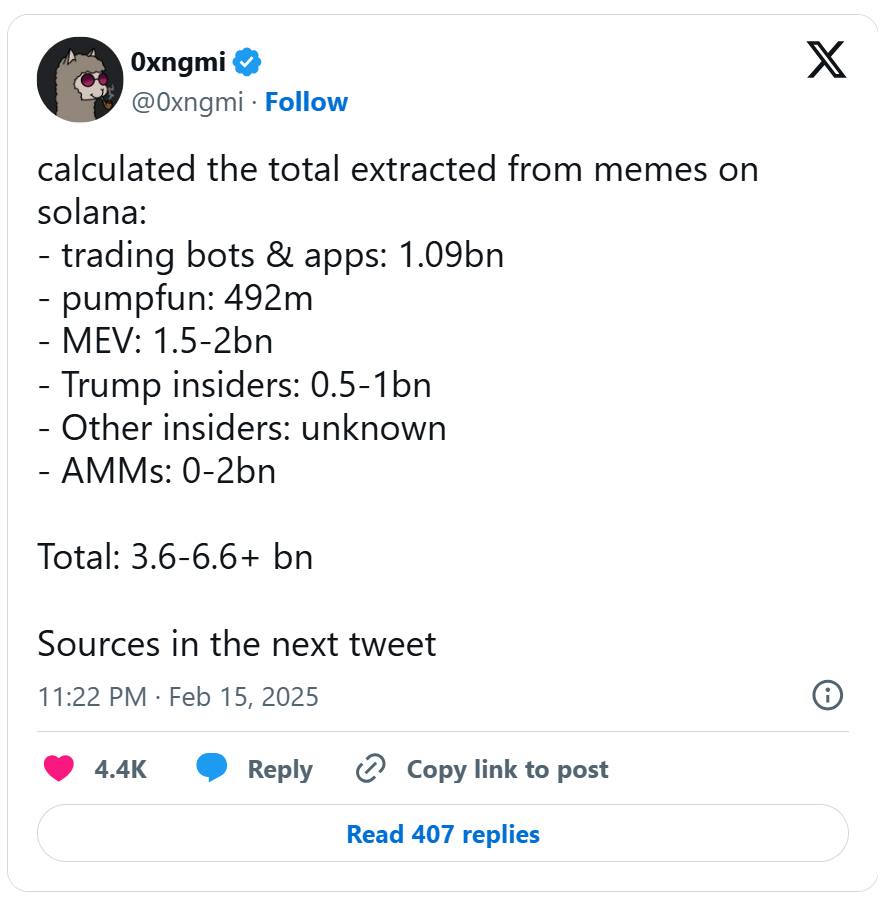As the Memecoin market experiences violent fluctuations, many traders are beginning to question the status of Pump.fun as the center of this ecosystem. This article explores the recent collapse of Memecoins and their potential future direction, analyzing changes in market liquidity and investor sentiment. The article is based on a piece written by Ryan S. Gladwin and compiled and translated by BlockTempo.
(Background: Musk Warns: Memecoins are a Gamble, Don't Go All In! Thinking You Can Get Rich from Memes is Stupid)
(Additional Context: Celebrity Coin Launches Exploit Farmers, Rug Pulls Rampant... Is the Memecoin Cycle Over?)
The popular launch platform and cultural center Pump.fun saw a 64.6% decrease in the number of Tokens launched on Wednesday compared to the peak in January. At the same time, according to Dune data, the weekly graduation rate of Tokens has also dropped to the lowest level since July 2024. "Graduation" refers to Tokens reaching a certain market value threshold, which was previously $69,000 but was raised to $100,000 at the end of last year.
This lull has led some traders to believe that the Memecoin casino has closed and will never reopen. The founder of the crypto education platform Pluid, Loopify (alias), and a trader believe the Memecoin cycle has ended. They point out that data suggests the Memecoin craze has surpassed the peak of the previous Non-Fungible Token (NFT) bull market.
According to Dune data, since its launch in 2017, the most popular NFT marketplace OpenSea has generated $943 million in revenue, while Pump.fun has generated over $574 million in revenue since its launch in January 2024. Not to mention the revenue generated by trading bots, market makers, and other protocols critical to the Memecoin economy.

Others, seeing these statistics, believe it's time to abandon Pump.fun as the center of the Memecoin ecosystem.
"The Pump.fun era is over," said the anonymous trader and WIFToken deployer Solana Bateman in an interview with Decrypt. "They've never given back anything, but they've extracted too much." He added, "The difference between us and them is that we care about Solana, which is our home. They only care about filling their own pockets."
These accusations often target the launch platform, with critics arguing that it has not done enough to develop the market, simply selling off all the SOL generated by the platform - although the founders deny this claim. Bateman said the platform could improve by enhancing Token economics, building better liquidity pools, or providing more sustainable models, such as increasing Token unlocks at specific market caps.
"I also agree that Pump.fun's model is far from perfect, and I know the team has been working hard to find ways to improve," Pump.fun co-founder Alon Cohen said in an interview with Decrypt.
"The design space for managing user incentives after launching a Token is very broad, so perfecting this takes time. But from day one, Pump.fun has adhered to some principles that I believe are still valid today."
Cohen said these principles include maintaining a low barrier to entry when creating Tokens, while pursuing "simplicity and elegance," as complexity can push away retail investors. He also added that he believes Pump.fun's standardized contracts have had a "tremendously positive impact" on the ecosystem, as they reduce the risk of developers creating malicious contracts and abuse.
How did we get here?
The collapse of Memecoins can largely be traced back to the launch of the official Memecoin of Donald Trump, just days before his inauguration in January. The market was rife with frenetic sentiment, with speculators declaring a new era for Memecoins and cryptocurrencies.
The next day, Melania Trump also launched her own Token, causing TRUMPToken to plummet - and MELANIA quickly followed suit. The sentiment shifted rapidly, and traders began to realize the "scam" at play. According to DEX Screener data, TRUMPToken is down 85% from its all-time high, while MELANIA has dropped 94%.
These launched Tokens drained the liquidity of Memecoin traders, while also creating a large number of losers. Rennick Palley, the founder of the hedge fund Stratos, said in an interview with Decrypt that in the following months, more large Memecoin Tokens experienced massive pumps and dumps within 24 hours, causing significant losses for traders.
Most notably, LIBRA briefly soared to a market cap of $1.17 billion after being promoted on social media by Argentine President Javier Milei, only to crash 96% to $40 million within six hours. Afterward, widespread insider trading allegations emerged, involving multiple major protocols and influencers, and investigators found that the Memecoin's issuers had connections to the team behind Melania Trump's Memecoin.
As the narrative of Memecoins being a manipulated game gained traction, the market's fear of the industry's complete corruption reached unprecedented levels. Bateman believes this is the "final nail in the coffin" for Memecoins.
"At first, 'Memecoins' looked like a casino game," said Nick Vaiman, co-founder and CEO of the analytics firm Bubblemaps, in an interview with Decrypt. "But in reality, it's much worse: the game was rigged from the start." He explained, "Your odds of winning are almost zero, because the real winners are already predetermined: the insiders with advance knowledge, the savvy snipers who got in early, and the teams behind the scenes."
For some, this is enough to make them abandon Memecoins and start looking for more stable investments with real underlying value. VanEck portfolio manager Pranav Kanade said in an interview with Decrypt that he expects funds to flow out of Memecoins and into "some niche Altcoins," as they can provide more psychological comfort. But not everyone is convinced.
"Many people don't like traditional VC-backed Altcoins with grand visions," Loopify told Decrypt, "so they're more likely to stick to single-culture Tokens, or simply exit the market until new opportunities arise."
Crypto trader Murad Mahmudov once discussed his Memecoin investment theory, which centered on finding "cults" and buying their Tokens. However, according to CoinGecko data, none of the Tokens on his list have seen any gains in the past seven days.
In addition, the overall macroeconomic pressure is also driving the overall market decline. According to data from TradingView, since the launch of LIBRA, BTC has fallen 17%, the S&P 500 index has fallen 2.7% in the past month, and the Trump administration's tariff policy has exacerbated market instability.
"Global liquidity has recently declined, and MEME coins are particularly sensitive to this change," Palley said, predicting that "liquidity seems to have bottomed out, and MEME coins may recover in the next few months."
Some traders in the market also agree with this view. A MEME coin trader named 0xWinged believes that the market has overreacted, and predicts that Solana will rebound to $170 soon, and market liquidity will also flow back to the MEME coin sector.
"Fundamentally, human nature likes to gamble, and as the subsequent market liquidity rebounds, I believe the funds participating in gambling will also increase accordingly," Palley said, adding that "MEME coins will continue to exist."







